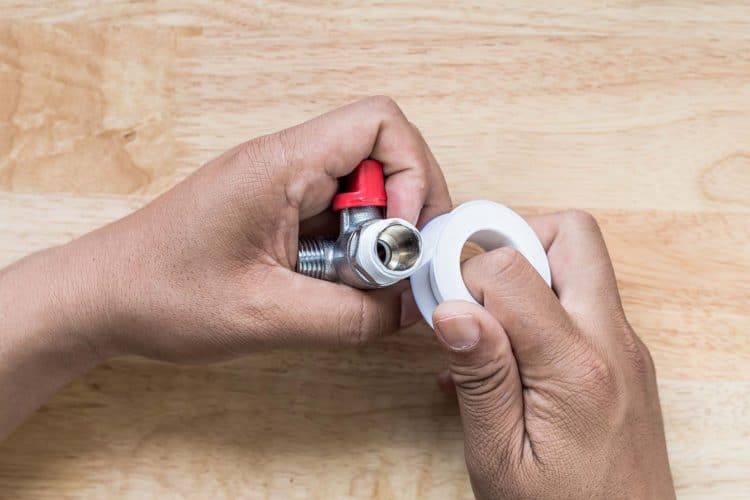Teflon is the brand name of the chemical coating called polytetrafluoroethylene, or PTFE. It was first created in the 1930s to serve as a non-stick surface.
It became famous for its use in cookware, but Teflon was also used for coating numerous other materials to make them waterproof. You could find it on everything from fabric to wires.
Until 2013, a chemical called perfluorooctanoic acid was used to create Teflon. It was so prevalent at one point that 98% of people had it in their blood during a 1999 study. That led to changes in how it was made.
PTFE doesn’t get heated in plumbing applications as it does with cookware, which means the same risks don’t apply.
Does Teflon Tape Stop Air Leaks?
Standard Teflon (PTFE) tape is a versatile product. It is useful for sealing air to prevent leaking through threaded connections, making it an essential component of high-pressure lines. It can also prevent gas and water leaks for residential and commercial installation points to improve a structure’s safety profile.
Teflon tape provides a straightforward way to complete DIY plumbing tasks. If you install a new showerhead, work on toilet water lines, or connect a washing machine to a home’s systems, this product reduces or eliminates leak risks.
It’s strong enough to stop air leaks from developing on high-pressure line connections, including gas lines that run into homes and businesses.
Applying the tape is a straightforward process. Here are the steps to follow if you have a threaded connection to manage.
- Clean the male threads of your pipe with a lint-free cloth or rag.
- Line up the end of the Teflon tape to the second thread from the end of the pipe.
- Hold it in place there with a thumb or a finger. You don’t want it to bunch up over the threads. The product should lie flat when applied correctly.
- Extend the tape perpendicularly to the pipe’s length.
- Start wrapping the Teflon tape in the same direction that the threads or pipe will turn when completing the installation.
- You’ll need to maintain tension on the tape to ensure it wraps snugly around the pipe. Keep working away from the end, overlapping the tape as you proceed.
- It usually takes four to six wraps around the pipe threads to complete the installation. You’ll want to finish near the end of the threads.
- Break the Teflon tape from the role by gripping it between your forefinger and thumb. Pull sharply. Smooth it down to create an even surface if any loose ends appear.
After completing these steps, the pipe is ready to go into the fitting process.
Most installations require a half-inch width to ensure the Teflon tape installs on the threads correctly.
When I’m working on the house, I use JACO ThreadPro PTFE Thread Seal Tape to get the work finished. It’s a pro-grade product that delivers a leak-proof, airtight seal on numerous surfaces.
I’ve used it successfully on copper pipes, brass, galvanized steel, aluminum, and threaded PVC connections.
A few years ago, we had to replace the plumbing in our shower. I used this tape on the threads to create a watertight seal. When it was time to replace the showerhead, I had to remove the old one and put on the new one because the JACO ThreadPro tape was still in excellent condition.
What Do the Different Colors of Tape Mean?
When you start shopping for Teflon tape, you’ll find that all manufacturers use a color-coded system to designate use.
The colors for PTFE tape are white, pink, yellow, green, and gray. Here is a closer look at when you’d use each one.
| Teflon Tape Color | Setting Where You’d Use This Teflon Tape Color |
| White | White Teflon tape is the standard color used for basic plumbing work. It’s good to have a couple of rolls available for those times when you need to stop a quick leak. It resists high temperatures and tightly seals threaded connections. |
| Pink | This option is commonly used by plumbers and pipefitters. It’s meant for water lines, providing a more heavy-duty option than other choices. |
| Yellow | PTFE tape of this color is meant for gas lines. It’s suitable for use with natural gas, propane, butane, and others. |
| Green | This Teflon tape is meant to seal the connections made within oxygen applications. It doesn’t contain any grease, reducing the risk of having a fire start. |
| Gray | Gray Teflon tape offers a high-density rating and is about twice as thick as other products. That makes it an ideal choice for stainless steel threads since it prevents galling and seizing. |
Some manufacturers use red for Teflon tape. This option is three times the density of the white product. It’s used for pipes with larger joints and serves a similar purpose to the pink option.
Although Teflon tape works well in most situations, you can end up using too much of it. If you go beyond four to six wraps, it is possible to crack the female adapter in your setup. Should that happen, you’d have a leaky fitting.
When you don’t use enough Teflon tape, the fitting can still leak.
The best way to get a good wrap is to give the tape a tight tug without enough force to have it break.
After hand-tightening the connection, use channel locks or something similar to tighten things even further.
How to Remove Teflon Tape from a Fitting
Putting on Teflon tape is often easier than removing it, but the work isn’t impossible. It helps to have a wire brush, an old toothbrush, clean rags, and hot water available.
Start by gently removing the tape from one end. It can be a bit rigid, but some installations are still pliable.
If you can lift it with your fingers, the product should peel off. Take your time with this process since working quickly can cause it to break.
If you can’t get the tape to lift with your fingers, the wire brush can get under the surface to get the job done.
The tape might leave some residue behind. If hot water doesn’t remove it, you can use lemon juice or white vinegar to cut through the lingering adhesive.
Rub the threads with a clean rag after removing the tape from the surface. You might need to brush out dirt and debris with the toothbrush.
Give it another cleaning and allow the pipe to dry before applying any new Teflon tape to the connection.
Do I Need to Have Teflon Tape at Home?
Having Teflon tape at home means it only takes a few wraps of the product to create leak-free connections. It’s used by DIY experts and professionals alike to stop air, liquid, and gas from escaping, even in high-pressure lines.
I was first introduced to Teflon tape in the winter of 2007. Our sprinkler system had been disconnected, but the service company failed to blow it out. We ended up with a burst line right next to the house.
After thawing out the pipes, I had to replace the broken connections. I started by using putty, but found I was nowhere near capable of using the purple stuff. That’s when my neighbor gave me a spare roll of Teflon tape.
I wrapped it as instructed, secured the connection, and tested the joint. It worked like a charm!
I’ve made sure there are a couple rolls available at home now at all times for whenever something comes up. Whether you own or rent, I highly recommend everyone do the same.

